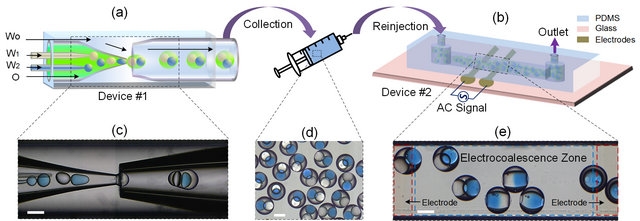Reported by: Wang Ji
Translated by: Sun Jianyao
Edited by: Garrick Jones
Date: 2017-04-10
Recently, the research group of Professor Jiang Hongyuan from the Mechanical Design Department of College of Mechanical and Electrical Engineering of HIT makes new progress in the field of droplet-based nano-upgraded microreactor research. Two research theses Continuous Electrification of Core Droplets in Doubled Billet Drops and Their Microreaction Applications and Electrification Fusion of Pair Nuclei in Dilute Emulsion have been published in the Applied Materials and Materials Interface (impact factor 7.145) of American Chemical Society and Chip Lab (impact factor 5.586)of the Royal Society of Chemistry respectively.
Droplet microfluidic technology has rapidly become a hotspot in the field of microfluidics for its high throughput,free of cross contamination and rapid response. Bubble droplets ( droplets in droplets), with its novel core-shell structure, ensure that all cores are in the same environment, effectively avoiding cross-contamination during microreactions. At the same time, it can achieve the expected controllable reaction process in the scale of nano-liter, so it has a bright application prospect in many fields, such as the material synthesis, artificial washing, biological monitoring, drug screening and sustained release and so on.
However, how to efficiently control the fusion of binuclear and multi-core double emulsion droplets is both the prerequisite for the above application and a major problem for droplets as microreactors. Over the years, Professor Jiang Hongyuan and his team have accumulated rich experience in the field of micro-nano-fluid regulation, and now put forward a new method to realize the controllable fusion of dual-core and double emulsion droplets by using low-voltage AC electric field, and have realized the mass precision control and integration,so as to solve the above problems as well as provide an efficient and controllable response platform for the biological, chemical and other micro reaction in the nano-liter or even picoliter level.
Professor Ren Yukun and Professor Jiang Hongyuan are the corresponding authors, doctoral students Hou Li Kai and Jia Yankai in this team are the first author of the two papers respectively. HIT is the only signature unit of the above papers. The project is supported by the National Natural Science Foundation of China, the National Key Laboratory of Robotics Technology and Systems, and “Innovative Research Group Fund for Robot Basic Theory and Key Technology” Funds for Creative Research Groups of China.
Original link:
(1) Application Materials and Interface: http://pubs.acs.org/doi/abs/10.1021/acsami.7b00670
(2) Chip Lab: http://pubs.rsc.org/-/content/articlehtml/2016/lc/c6lc01052k
(3) Chip Lab: http://pubs.rsc.org/en/content/articlehtml/2017/lc/c6lc01346e
(4) Chip Lab: http://pubs.rsc.org/-/content/articlehtml/2016/lc/c6lc00485g
(5) Analytical Chemistry: http://pubs.acs.org/doi/abs/10.1021/acs.analchem.6b03413





